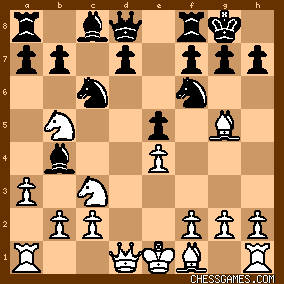| KEG: A fine example of Schlechter's cool and accuracy when under fire. Blackburne tried to launch an unsound attack and got mercilessly outplayed and wiped out by Schlechter. Playing over this game, Schlechter appears to be a class or so above Blackburne. Yet their lifetime record showed Blackburne ahead, 3 wins to 2 with 6 draws. This record is a bit misleading, since Blackburne was ahead 2-0-4 before London 1899 (i.e., before Schlechter became the brilliant player that enabled him to draw matches against Lasker, Tarrasch, and Pillsbury and to destroy Janowski in their match). This game brought Schlechter even with Blackburne in their lifetime encounters. Blackburne did, however, have the last laugh and won his final game against Schlechter in Ostedn 1905. 1. e4 c5
2. Nf3 Nc6
3. d4 cxd4
4. Nxd4 Nf6
The Tournament Book gives a slightly different move order (i.e., 4...e6 5. Nc3 Nf6) 5. Nc3 e6
6. Ndb5
The most radical choice. Other recognized and reasonable options were 6. g3, 6. NxN, 6. a3, and 6. Be2 6... Bb4

click for larger view6...d6 (transposing to the Pelican Variation) is more usual and solid, but the text--which is quite playable--is exactly what we would expect from the hyper-aggressive Blackburne. 7. Bf4
"!"--(Tournament Book)
"The variation 7. Nd6+ [after which could follow 7...Ke7 8. NxB+ RxN 9. Bd3 d5--with about equal chances--KEG] is not good for White, so he seeks to restore the attack by an inversion of moves. It is also possible that this move is the result of preparation, the Sicilian being in vogue." (Schlechter/Sittenfeld). The text, however is flaws (see below) and the usual and best move for White today is 7. a3. 7... e5
"This move is inferior to 7...0-0." (Schlechter/Sittenfeld). But after 7...0-0, White gets some advantage with 8. Bc7. Simples and best is the "normal" 7...Nxe4. Rightly or wrongly, however, Blackburne may not have liked the looks of such wild lines as 7...Nxe4 8. Nc7+ Kf8 9. Qf3 Nxc3 10. bxN Qf6 11. bxB QxR+ 12. Qd1 QxQ+ 13. KxQ e5 14. Bxe5 NxB 15. NxR (which in fact looks about even). 8. Bg5
White has lost a tempo with his Bishop, but Black has lost a tempo with his e-pawn. All in all, White is slightly better: 
click for larger view8... 0-0
9. a3

click for larger view9... BxN+
"If 9...Be7 10. Nd6 threatens Nf5 with an excellent game." (Schlechter/Sittenfeld) In fact, 9...Ba5 keeping his Bishops and leaving White the task of organizing his Knights was better. 10. NxB h6
11. Bh4 d6
12. Qd3
"!"--(Tournament Book)
"The only correct way to continue the attack." (Schlechter/Sittenfeld) 
click for larger viewBlackburne's play had indeed by this point given Schlechter attacking chances, but Black's position was not all that bad. But from here, as will be seen, Blackburne erred and Schlechter ground him to dust. | 




